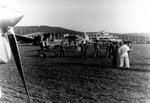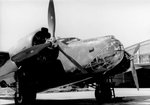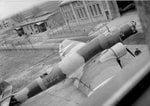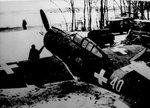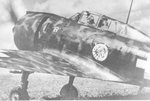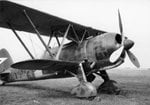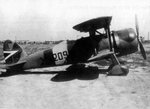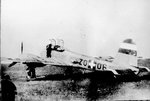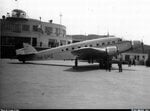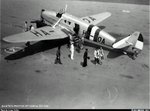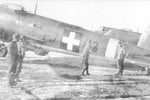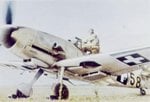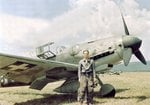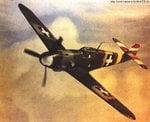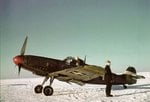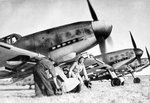Following the dissolution of the Austro-Hungarian Monarchy in 1918, a small air arm was established operating surviving aircraft from Hungarian factories and training schools. This air arm became the Hungarian Red Air Force under the short lived Hungarian Soviet Republic, but was disbanded upon its downfall. Under the Treaty of Trianon (1920), Hungary was forbidden from owning military aircraft. However, a secret air arm was gradually established under the cover of civilian flying clubs. During 1938, the existence of the Magyar Királyi Honvéd Légierő (MKHL; the Royal Hungarian Air Force), was made known. The air arm was reorganized and expanded. On January 1, 1939, it became independent of the army.
It subsequently participated in clashes with the newly established Slovak Republic and in the border confrontation with Romania. In April 1941, operations were conducted in support of the German invasion of Yugoslavia and, on June 27, 1941, Hungary declared war on the Soviet Union. On March 1, 1942, the air force was returned to army control. In the summer of 1942 an air brigade was attached to the Luftwaffe's VIII. Fliegerkorps on the Eastern Front. Beginning March 1944, Allied bomber raids began on Hungary and progressively increased in intensity. Late in 1944 all efforts were redirected towards countering the advancing Soviet Army, but to no avail. All fighting in Hungary ended on April 16, 1945.
A small air arm was organised along Soviet lines during 1947. Following the communist takeover, Russian military aid was stepped-up and a major expansion program initiated. When Soviet forces invaded in November 1956 to suppress the national uprising, sections of the Hungarian Air Force attacked Soviet forces and resisted Russian attempts to occupy their bases. The resistance was short-lived and the air force was demobilized soon after. A reconstituted air arm was reformed in the following year, but initially only as an internal security force. Gradually, the air force was expanded again, but it remained an integral part of the army and was essentially a defensive force. The soviets had MIG 29s based at Tokol until 1991 to defend Hungarian airspace.
In mid 1993 three batches of the MIG 29s were delivered from Russia. They were based at Kecskemet. In 1994 a German gift of 20 MIL 24D/V's and 20 L-39's were donated. In 1997 Hungary undertook its first flying training course since 1956. The cost of the course was too high and was halted after the completion of only one course. Also in 1997 the MIG 23s and SU 22s were withdrawn from service. During the 1990s all combat aircraft were fitted with new Identification Friend or Foe (IFF) systems to enable operations in western airspace. In April 2002, Hungary joined the NATO Flying Training in Canada (NFTC) pilot training program.
It subsequently participated in clashes with the newly established Slovak Republic and in the border confrontation with Romania. In April 1941, operations were conducted in support of the German invasion of Yugoslavia and, on June 27, 1941, Hungary declared war on the Soviet Union. On March 1, 1942, the air force was returned to army control. In the summer of 1942 an air brigade was attached to the Luftwaffe's VIII. Fliegerkorps on the Eastern Front. Beginning March 1944, Allied bomber raids began on Hungary and progressively increased in intensity. Late in 1944 all efforts were redirected towards countering the advancing Soviet Army, but to no avail. All fighting in Hungary ended on April 16, 1945.
A small air arm was organised along Soviet lines during 1947. Following the communist takeover, Russian military aid was stepped-up and a major expansion program initiated. When Soviet forces invaded in November 1956 to suppress the national uprising, sections of the Hungarian Air Force attacked Soviet forces and resisted Russian attempts to occupy their bases. The resistance was short-lived and the air force was demobilized soon after. A reconstituted air arm was reformed in the following year, but initially only as an internal security force. Gradually, the air force was expanded again, but it remained an integral part of the army and was essentially a defensive force. The soviets had MIG 29s based at Tokol until 1991 to defend Hungarian airspace.
In mid 1993 three batches of the MIG 29s were delivered from Russia. They were based at Kecskemet. In 1994 a German gift of 20 MIL 24D/V's and 20 L-39's were donated. In 1997 Hungary undertook its first flying training course since 1956. The cost of the course was too high and was halted after the completion of only one course. Also in 1997 the MIG 23s and SU 22s were withdrawn from service. During the 1990s all combat aircraft were fitted with new Identification Friend or Foe (IFF) systems to enable operations in western airspace. In April 2002, Hungary joined the NATO Flying Training in Canada (NFTC) pilot training program.




